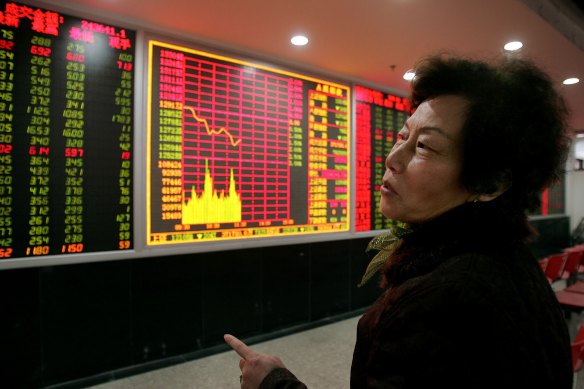
“We see an urgent need for more convincing, proactive government support to tackle the vicious cycle.”
“The disappointing follow-through from the MLF cut to the LPR strengthens our view that the PBOC is unlikely to embrace the sizable declines needed to revive credit demand,” wrote economists at Capital Economics Ltd. including Julian Evans-Pritchard. “The upshot is that while monetary easing will provide some relief to indebted firms and households, it won’t be enough to put a floor beneath growth. Instead, the key will be the extent of fiscal support.”

China’s sharemarkets slumped on the news.Credit: AP
Weak data recently has prompted several banks to cut their growth forecasts for the year to below 5 per cent, implying the government may miss a growth target set earlier this year. Investors are also concerned about contagion risks following a liquidity crisis at a major shadow bank.
Several analysts suggested that Chinese banks may have been limited in their ability to lower their prime rates even with last week’s policy rate cut, which was intended to reduce bank financing costs and encourage them to lend more.
Chinese banks have experienced narrowing interest margins and lower profitability in recent years due to fiercer competition in the credit market and a decline in lending rates since the pandemic, the PBOC said in a special section of its quarterly report published last week. Banks need to maintain “reasonable profits and net interest margins” so they can serve the real economy and prevent financial risks, the PBOC said.
Loading
Lenders may have also been constrained because average new mortgage rates are at record lows. The average fell to 4.11 per cent in June, according to last week’s PBOC report.
Last year, the five-year LPR was cut by a total of 35 basis points — more than the 20-basis point reductions seen in the MLF rate, and deeper than the 15 basis points worth of trims to the one-year LPR.
“The lack of ability to lower the LPR rate, which is determined by banks, even with such a strong MLF rate cut suggest more measures to lower banks’ cost of liabilities will become more urgent,” said Becky Liu, head of China macro strategy at Standard Chartered.
She suggested more actions may be forthcoming, including some combination of a cut to the reserve requirement ratio for banks, reduced deposit rates and trims to re-lending rates.
Monday’s actions also send a signal “that authorities don’t want the property market to overheat,” said Bruce Pang, chief economist and head of research for greater China at Jones Lang LaSalle.

China’s property woes are getting worse.Credit: AP
“There has been speculation on whether the government will completely let loose property policies after the Politburo meeting omitted the pledge that housing is not for speculation,” he said, referring to a meeting held last month by the Communist Party’s top decision-making body.
The absence of that slogan, a signature of President Xi Jinping, has fuelled speculation that some tough restrictions on property would be reversed.
“The signal now is that there will still be policy controls on the property sector, just that they will be optimised,” Pang said, adding that authorities have also introduced a mechanism for lowering new mortgage rates already, lessening the need to adjust the five-year LPR.
Loading
Policymakers may also have judged that cutting the mortgage reference rate “is not the most effective tool,” said Frances Cheung, rates strategist at Oversea-Chinese Banking.
“Either that’s it, or the regulators are mulling something more substantial in supporting the property sector,” she added.
Bloomberg









 Add Category
Add Category